POULTRY FEEDERS
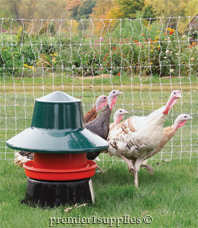
Use a mineral tub to lift the King Feeder with green rain hat off the ground.
Closeout
Poultry Feeders
For those who need a feeder for their free-range poultry, consider the options below:
They're available with optional rain hats so they can be used in inclement weather. The King feeder is useful for waterfowl and other large-beaked birds. The Handy and Ascot feeders accommodate small and medium flocks of poultry.
See all of our
Closeout Poultry Products.
MOTHER EARTH NEWS FAIR
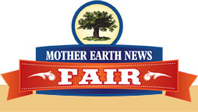 Visit us at Mother Earth News Fair
Visit us at Mother Earth News Fair
Premier's booth #1570 & 1571
Puyallup, WA
May 31-June 1, 2014
Premier's booth #151 & 153
Seven Springs, PA
September 12-14, 2014
Premier's booth —TBA
Topeka, KS
October 25-26, 2014
RECIPE
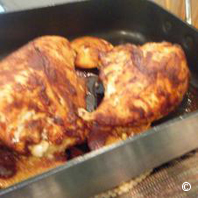 Honey Sweet & Spicy Chicken
Honey Sweet & Spicy Chicken
Ingredients
| • |
Non-stick cooking spray |
| • |
2 navel oranges |
| • |
¼ cup sweet paprika. |
| • |
2 tablespoons garlic powder |
| • |
2 teaspoons chili powder |
| • |
1 teaspoon ground dry ginger |
| • |
½ teaspoon ground chipotle pepper |
| • |
¼ teaspoon salt |
| • |
¼ cup honey |
| • |
2 tablespoons low-sodium chicken broth |
| • |
2 (2½ to 3 lbs total) large chicken breasts with skin and ribs |
Directions
Preheat oven to 375°F. Spray a roasting pan with nonstick cooking spray. Slice off and discard the ends of each orange. Cut each unpeeled orange crosswise into 3 thick slices. Arrange slices in a single layer on bottom of roasting pan. In a small bowl, combine paprika, garlic powder, chili powder, ginger, chipotle pepper and salt. Stir in honey and broth to form a thick paste. Spread paste thickly and completely over all sides of chicken breasts.
Place coated breasts directly on top of orange slices. Roast for 40 to 45 minutes or until chicken reaches an internal temperature of 165°F.
Cut each chicken breast in half. Carefully squeeze cooked orange slices over chicken using tongs.
Photo and recipe courtesy of National Honey Board
|
 |
 |
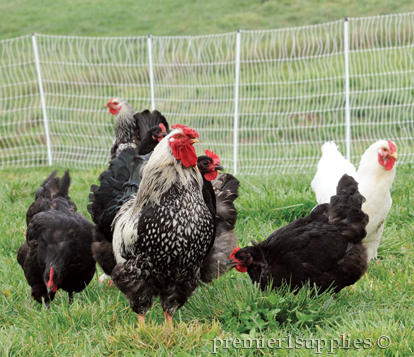
A Silver Laced Wyandotte rooster keep watching over the flock. Since the flock is surrounded by PoultryNet™ 12/42/3, he doesn't have to serve predator guard duty as he would without PoultryNet.
Hens, chicks and ducklings
We have chicks! And ducklings! It's been a busy week getting ready for the just-hatched birds, shipped to us by mail. We rounded up feeders, waterers, chick stands, heat plates and heat lamps in preparation for their arrival.
Meanwhile our older hens are enjoying their pasture over on the East Farm. Their egg production is just about at the season's peak so the Premier staff is enjoying dozens of fresh eggs on a weekly basis. The hens spend their non-egg-laying hours scratching outside in the pasture. They're protected by a few rolls of PoultryNet™ Plus and an energizer kit.
For added security, we use the Automatic Poultry Door, which opens in the morning and closes at night. This keeps the hens safe and secure in the coop during night hours and allows them to go outside at first light, freeing their caretaker from being on hand twice a day to let them out and shut them in. We (and the hens too!) quickly became accustomed to the convenience and reliability of this autodoor.
We use a variety of feeders and waterers for our hens. Indoors we prefer the Saturn 15 feeder; outdoors we like to use the Handy Feeder (it has an optional rain hat). For an all-around waterer, the QuickClean 5 gallon bucket waterer works well for us. The 3 gallon version with legs is especially useful indoors, keeping the waterer above the bedding.
If you're thinking of changing up your feeders and waterers, you'll find the information below helpful in making those decisions.
Watering and Feeding Charts
How many chicks or chickens can a water or feeder handle? Consult these charts above for the recommended numbers.
A feeder should:
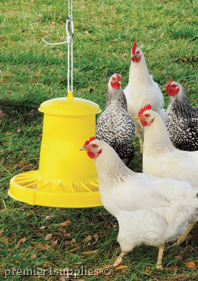
The Saturn 15 feeder is one of our preferred poultry feeders. It is easy to use and the birds respect the grills (it's more difficult for them to scratch out feed and waste it).
|
| • |
Keep feed dry
(if outside). |
| • |
Be easy to refill. |
| • |
Hold enough feed to keep refills to a minimum. |
| • |
Minimize feed waste. |
We prefer to use feeders for adult birds that have a grill. Grills or guards prevent birds flicking and scratching feed out onto the ground with their beaks. Keep feeders for adult birds several inches off the ground so they can’t easily scratch bedding and litter into the feed.
For chicks, you can achieve the same useful separation between bedding and water/feed with a Chick stand.
|
Saturn 15 Feeder
Linda S from Ohio
    
Would you recommend this product? Yes
Love this feeder. Great for smaller flocks or newbies being added to an established flock. Love hanging feeders and this one is very nice and priced right.
View our New feeder videos…
|
|
Choosing a waterer…
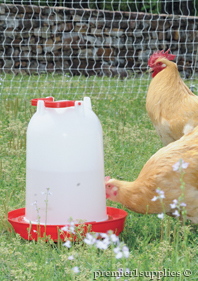
A pair of Buff Orpington's using Premier's Combination 12 waterer. All Combination waterers feature a sturdy handle that also can be used for hanging.
|
The size is dependent on:
| • |
Number and size of birds. |
| • |
How often you water them. |
Choose a waterer that will provide enough clean water for the birds between your visits to the coop.
If you have a few birds or frequently water them, you can manage with a smaller waterer. If you have many birds, you need a larger one, especially during the summer.
How much water will a bird drink in a day?
A medium-size adult chicken will drink about 0.08 gal (just over a cup) on a hot day. Temperature in the coop, size and age of the bird, and amount of salt in the feed will cause this figure to vary.
For chicks use a small waterer with a drown-proof or narrow-lipped base.
For waterfowl use a waterer with a wide base so they can easily fit their wide beaks into the tray.
If you dislike your waterer, try a different design. Some users prefer one style over another.
For those who need a feed scoop, check out our Turbo Scoops.
Waterer tips:
| • |
Be sure the waterer is level. This enables the internal float to work properly—and prevents water overflowing and running onto the floor, soiling the bedding. |
| • |
Clean them often. Hard-water deposits or algae may build up. Wash waterers with soapy water to reduce potential bacterial growth. Make sure to rinse away all suds after cleaning. |
| • |
Birds like to scratch near waterers—which puts filth in the trough. To reduce this, elevate waterers so they’re as high as the base of a bird’s tail. (Hang the waterer or set it on a block.) |
| • |
Place waterers for adult chickens on cinder blocks, or on Chick Stands for chicks. This seems to reduce the birds splashing water out onto the soil or bedding. |
| • |
Waterfowl tend to make mud holes near their water sources—so change the waterer’s location often. |
| • |
When using a waterer outside, do not place it in the sun as this will cause increased evaporation. Or use a waterer with large capacity in sunny locations. |
|
|
|
HOBBY FARMS.COM
Start a Successful Egg Business...
By Wendy Bedwell-Wilson
A profitable egg business requires more than raising healthy chickens. Use these tips to get your egg business up and running.
Perhaps the only thing better than cracking, cooking and savoring your own farm-fresh eggs is sharing a dozen or two with family and friends—and the occasional cash-paying customer. More of these consumers exist today, and small-flock growers are reaping the rewards, thanks to growing awareness of the health benefits of pasture-raised eggs.
READ MORE »
EXTENSION NEWS
Producing Poultry on Pasture
By Adam A. Hady, UW Extension Cooperative Extension
Pastured poultry is a system of raising poultry for meat, eggs, or pleasure on a pasture management system. This publication will focus mainly on chickens, but the concepts are true for all types of poultry, such as ducks and turkeys. For producers with limited resources or for those who wish to raise poultry at home, the pastured poultry management system has both benefits and drawbacks.
READ MORE »
|
|